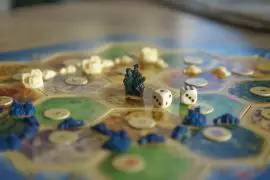Card Games
Contents
Card games are an excellent way to learn new skills and have inexpensive fun simultaneously. Card games help us learn mathematics and logic and provide mental exercise that stimulates attention to detail and improves memory.
Types of Card Games
Nearly all card games belong to one of three groups:
- games in which the object is to get rid of all cards held in hand;
- games in which high cards win tricks; or
- games in which the game’s object is to put the cards together in order and sets.
Card games played by one person alone are called solitaire. In other games, two or more players compete individually, or games can be played that require players to play with one or more partners as a team.

Rules in card games
Before playing any game, all players need to know the rules or agree on how they should play the game, how to keep score, and how to win the game. Books are available that include the rules for many games. The more games you know how to play, the more fun you can have with cards.
History of Card Games
Probably made the first playing cards in China or India hundreds of years ago. From these countries, card games spread throughout the Far East and across the Indian Ocean to Arabia and Egypt. In earlier times, they used cards for telling fortunes and playing games.
The first playing cards were painted by hand. Later, they printed cards from wood-cuts and carved them. The design was on a block covered with ink and pressed against paper. The color was added later. Some early playing cards were round in shape, and some were square. It was many years before cards became rectangular and easy to handle.
Originally cards had no numbers in the corners. A player had to look carefully at the front of each card and count the number of pips, or spots, on the card to know its value. In the late 1800s, placed index numbers in the corners. Then it was easier to hold many cards in a fan shape and see every card at a glance.
Modern cards are printed on pasteboard and coated with Plastic to make them last longer. The advantage of cards made of pasteboard is that it is impossible to see through them, even when they are held under intense light. Playing cards were first brought to America by the sailors on Columbus’ first voyage in 1492. Almost all of the founders of our country, including George Washington, Thomas Jefferson, and John Q. Adams, found time to play cards. Benjamin Franklin not only played cards but also printed and sold them.
Card games are played in just about every country in the world today, and similar games are played in many countries. Most of the games that are played today are based on old ones that have been played for hundreds of years.
Board Games
A board game is played on a flat surface called a game board, which may decorate. Board games have been played for more than 4,000 years. The earliest game boards discovered are more than 3,500 years old. In Asia, board games developed later, perhaps not until about 400 B.C. Board games were top-rated in ancient Greece and Rome, and from there, they spread to other parts of Europe. Some early games may have had a religious purpose.
Board games generally involve two basic types of play—strategy and racing. Many board games are a combination of both. The objectives of games of strategy are to capture or block opposing pieces, to gain control of more significant portions of the game board, to enter pieces on the board so that a number of them form a row, or to trap or eliminate prey. In racing games, the primary objective is to begin at one point on the game board and race along one or more paths to a finishing point.
Can we consider card games as board games?
Even though they don’t have a board, card games are frequently bundled in with board games. You could think of the table as the game board for cards.
The table forms the card game board. You can purchase play mats with these areas marked for the card layout in Magic: The specific Gathering.

When playing a board game, cards are frequently an essential component. I am so comfortable playing board games with cards that even when a game only uses cards, I still feel like I am playing a board game.
Similarities between card games and board games
- played with others
- played on a table
- Cards are moved around in the same way that board game pieces are.
- similar game abilities and playing styles
- high-quality components and lovely artwork
- usually kept in a box
Therefore, even if a card game technically isn’t a board game because it doesn’t have a board, the overall opinion is that card games are considered to be board games.





